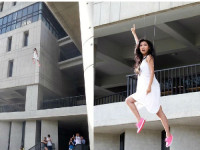【站在巨人肩膀上】DrawableLayout_ToolBar_FloatingButton
来源:互联网 发布:mac地址无法修改 编辑:程序博客网 时间:2024/05/17 03:03
在这一篇文章里,将会介绍如何使用DrawableLayout和toolBar打造一个具有侧滑效果的界面。参考了超简单方式打造策划菜单。
第一步,创建三个xml文件。toolBar.xml,content.xml,主布局文件(这个一般在我们创建activity的时候已经创建好了,没有你就自己创建吧)
1.toolBar.xml
<?xml version="1.0" encoding="utf-8"?><android.support.v7.widget.Toolbar xmlns:android="http://schemas.android.com/apk/res/android" android:layout_width="match_parent" android:layout_height="60dp" android:id="@+id/toolbar_main" android:background="@color/colorPrimary" > <TextView android:layout_width="wrap_content" android:layout_height="wrap_content" android:text="AuthorByChumFuchiu" android:textSize="24sp" android:layout_gravity="center" android:textColor="#ffffff" /></android.support.v7.widget.Toolbar>
很简单,根布局为toolbar,里面有一个子view为textview。
2.content.xml
这个布局文件的根布局为drawableLayout,子布局分为两个布局,一个是主页面布局,一个是侧滑页面的布局。而drawableLayout根据这些个子布局中包含了layout_gravity属性的值,为它们设置想到对应的位置(所以说,按道理你的侧滑页面可以从上下左右四个方向出来,哇,是不是特别灵活?)
<?xml version="1.0" encoding="utf-8"?><android.support.v4.widget.DrawerLayout xmlns:android="http://schemas.android.com/apk/res/android" android:id="@+id/drawable_main" android:layout_width="match_parent" android:layout_height="match_parent"> <LinearLayout android:layout_width="match_parent" android:layout_height="match_parent" android:id="@+id/ll_content" android:orientation="vertical" android:background="#ffffff" > </LinearLayout> <!--android:layout_gravity="start"属性使这部分作为侧滑部分--> <!--android:gravity 属性是对该view中内容的限定,而 android:layout_gravity是用来设置该view相对与父view 的位置--> <LinearLayout android:id="@+id/ll_menu" android:layout_gravity="start" android:orientation="vertical" android:background="#5EA9CC" android:layout_width="match_parent" android:layout_height="match_parent"> </LinearLayout></android.support.v4.widget.DrawerLayout>
好了,两个布局文件搞完了,直接把他们include到activity的布局文件中就完事了。这里要强调的是,在主布局文件中根布局LinearLayout的orientation属性一定要写好,不然不仅你的toobar的按钮显示不出来,而且你侧滑也没有效果的。
<?xml version="1.0" encoding="utf-8"?><LinearLayout xmlns:android="http://schemas.android.com/apk/res/android" android:layout_width="match_parent" android:layout_height="match_parent" android:orientation="vertical" > <!--toolbar--> <include layout="@layout/toolbar_main"></include> <!--drawablelayout--> <include layout="@layout/content_main"></include></LinearLayout>
布局文件搞定了,那么接下来还要修改的地方是style文件,我记得我昨天有写过一个博客关于style的actionbar与toolbar冲突的问题,但是我今天写这一篇博客的时候惊奇的发现,草稿箱里根本就没有那篇博客!!所以还是直接把修改后的style文件拿过来了。
<style name="AppTheme" parent="Theme.AppCompat.Light.DarkActionBar"> <!-- Customize your theme here. --> <item name="colorPrimary">@color/colorPrimary</item> <item name="colorPrimaryDark">@color/colorPrimaryDark</item> <item name="colorAccent">@color/colorAccent</item> <item name="windowActionBar">false</item> <item name="windowNoTitle">true</item> </style>
这个是我整个style的布局,主要添加了两行windowActionBar=false和windowNoTitle=true的代码,这样就不会报错了。你也可以把DarkActionBar修改为NoActionbar,也是可以解决问题的。
最后就是java代码了,东西也很少,在绑定了控件之后,直接调用这一行代码运行就行了。很简单。直接贴上来了。
private void initToolBarAnadDrawableLayout(){ setSupportActionBar(toolbar);//设置actionbar为我们的toolbar getSupportActionBar().setHomeButtonEnabled(true);//决定左上角的图标是否可以i安吉 getSupportActionBar().setDisplayHomeAsUpEnabled(true);//给左上角的图标设置一个返回图标 getSupportActionBar().setDisplayShowTitleEnabled(false);//展示标题 //将toolbar与DrawableLayout进行绑定 mToggle=new ActionBarDrawerToggle(MainActivity.this,drawerLayout,toolbar,R.string.open_draw,R.string.close_draw){ @Override public void onDrawerClosed(View drawerView) { super.onDrawerClosed(drawerView); } @Override public void onDrawerOpened(View drawerView) { super.onDrawerOpened(drawerView); } }; drawerLayout.addDrawerListener(mToggle);//为drawableLayout设置监听器。 mToggle.syncState(); }
最后就是FloatingActionButton(悬浮按钮),用法和普通的button一模一样。不过要使用的话,如果你项目里面没有他的包,那么首先得添加这么一条依赖
compile 'com.android.support:design:25.0.0'
然后是布局文件
<android.support.design.widget.FloatingActionButton android:layout_width="wrap_content" android:layout_height="wrap_content" android:layout_alignParentBottom="true" android:layout_alignParentRight="true" android:layout_marginBottom="50dp" android:layout_marginRight="20dp" android:src="@drawable/fly_button" android:id="@+id/float_btn" app:fabSize="normal" android:onClick="floatLocation" app:backgroundTint="@color/colorPrimary" app:rippleColor="#7ea19f" />
里面就比普通的button多了三条app属性,从上往下分别是尺寸,背景色,点击后的颜色。
好了,关于DarawableLayout,Toolbar,FloatingButton的使用小结就到这里了。
- 【站在巨人肩膀上】DrawableLayout_ToolBar_FloatingButton
- 站在巨人的肩膀上
- 站在巨人的肩膀上
- 站在巨人的肩膀上
- 站在巨人的肩膀上
- 站在巨人的肩膀上
- 站在巨人的肩膀上
- 站在巨人们的肩膀上
- 继承--站在巨人的肩膀上
- 站在巨人的肩膀上
- jmheart站在巨人的肩膀上
- 站在巨人的肩膀上学习
- 站在巨人肩膀上的人
- Python--站在巨人肩膀上
- 站在巨人的肩膀上
- 站在巨人的肩膀上学习
- 站在巨人的肩膀上--邵泓鑫
- 站在巨人的肩膀上
- android JNI 配置---Mac
- 关于我如何拿到携程offer的过程记录
- c++ 文件操作
- PyCharm配置mongo插件
- Armadillo4.4穿山甲加密教程(详细图文)
- 【站在巨人肩膀上】DrawableLayout_ToolBar_FloatingButton
- Numpy 排序(sorting)、查询(searching)、计数(counting)
- C++第一课
- ecshop前台分页功能
- install hadoop in docker
- UESTC
- Jquery(三)
- Populating Next Right Pointers in Each Node
- 两张背景图无间隙移动


